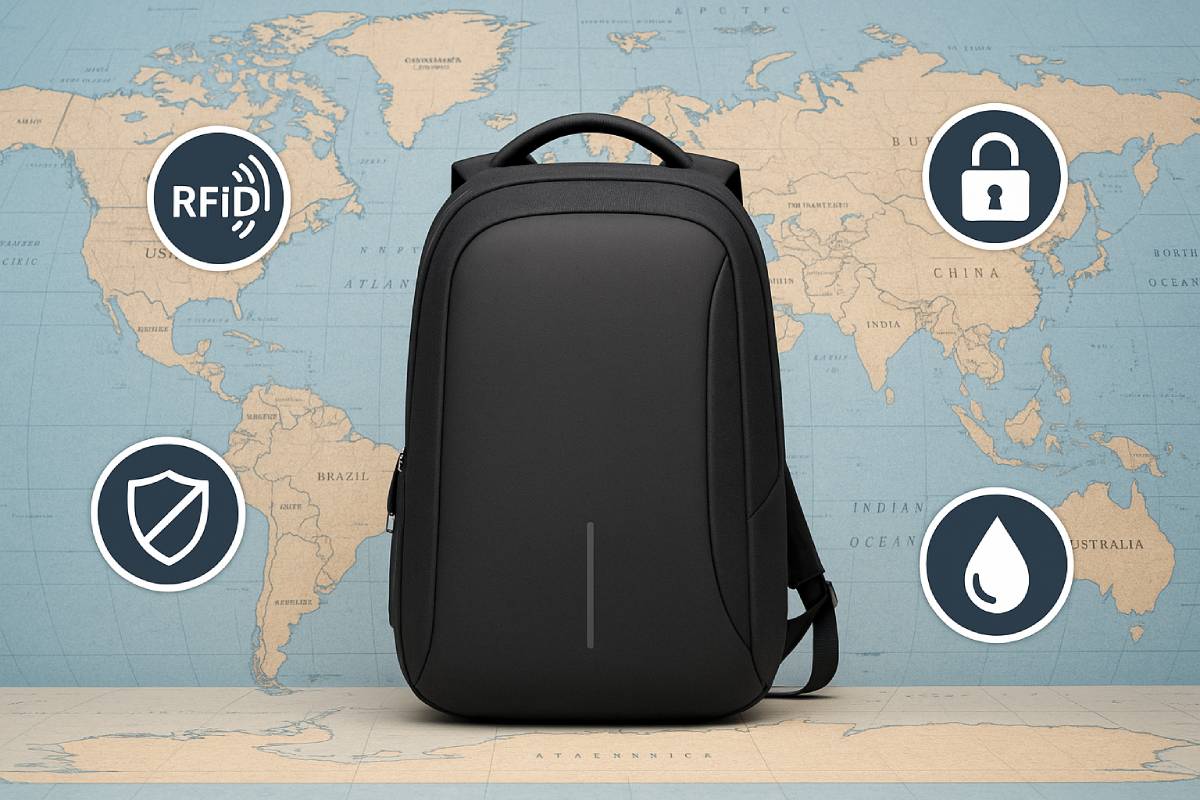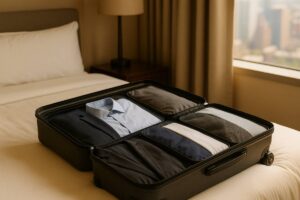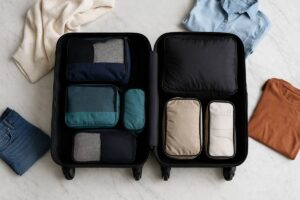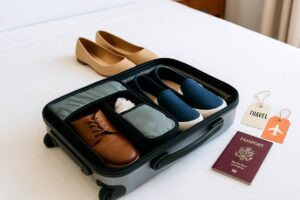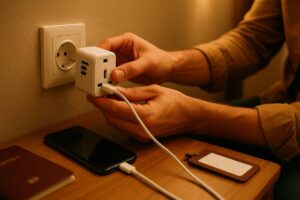Travel today means juggling passports, laptops, and power banks at every turn—and thieves know it.
From crowded subway cars to chaotic airport baggage claims, your gear is always at risk. What if one backpack could block RFID skimmers, foil knife attacks, and keep TSA agents happy—all while shrugging off rain?
In this guide, you’ll discover the real science behind RFID liners, slash-proof fabrics, TSA-approved locks, and more.
We’ll compare top materials, share traveler-tested reviews, and map features to your travel style—so you travel smarter, not harder.
Ready to transform your carry-on into the ultimate secure companion?
Common Travel Theft Scenarios

When you’re choosing an anti-theft travel bag, the first step is understanding where and how theft happens. Below, I break down the four most common travel theft scenarios—so you know exactly which features will keep your belongings safe on every leg of your journey.
Before we dive into specific features, here’s a quick snapshot of where theft is most likely to occur—and what you stand to lose:
| Theft Scenario | % of Reported Incidents¹ | Most-Targeted Items | Typical Loss (USD)² |
|---|---|---|---|
| Airport & In-Flight Risks | 22% | Checked luggage, carry-ons, passports | $120 |
| Public Transport & Ride-Shares | 34% | Backpacks, wallets, phones | $85 |
| Urban Streets & Crowded Markets | 28% | Purses, smartphones, cameras | $90 |
| Outdoor & Adventure Settings | 16% | Gear (cameras, drones), cash | $150 |
¹ Based on aggregated traveler surveys; percentages will vary by source.
² Average estimated replacement cost per incident.
1. Airport & In-Flight Risks
- Bag Mix-Ups & Misrouting: Even with RFID-tagged luggage, conveyor‐belt chaos can send your suitcase to the wrong carousel.
- “Hands-Off” Checked Luggage: Checked bags are out of sight—and often out of mind. Tamper-evident zippers and TSA-approved locks are critical.
- Cabin Overhead Bin Vulnerabilities: Opportunistic grab-and-go thieves can lift valuables from carry-ons. Look for hidden, lockable interior pockets and slash-proof straps inside the bag.
Pro Tip: Always keep essential documents and electronics in a small, front-carry daypack with built-in RFID lining and a discreet locking zipper.
2. Public Transport & Ride-Shares
- Crowded Conditions: Trains, buses, and shared rides are prime spots for pickpockets. Back-carry bags with reinforced, slash-proof backs deter grab-and-run thieves.
- Unattended Bags: A quick bathroom break on a long bus ride can end in disaster. Choose a bag with anchor cables or an integrated security cable you can loop around a seat frame.
- Door-To-Door Handling: Loading and unloading at multiple stops increases exposure. Opt for cut-resistant fabrics (Kevlar or steel-wire mesh) that stop slash-and-grab attempts.
3. Urban Streets & Crowded Markets
- Close-Quarters Pickpocketing: Touristy districts and bazaars attract professional teams—one distracts while another unzips. Hidden zipper tracks and internal slash-proof pockets are your best defense.
- Shoulder Bag Snatchings: A quick tug can send an unprepared bag flying. Slash-proof straps with steel cables and anchor loops make snatching nearly impossible.
- Overnight “Hotel” Heists: Even locked rooms can be breached. Choose a bag that secures to immovable objects (via integrated cables) and stashes valuables in hidden compartments under a false lining.
4. Outdoor & Adventure Settings
- Trail & Campsite Theft: At rest stops, criminals may scope out unattended gear. Bags with modular locking points allow you to tether your pack to a tree or bike rack.
- Beach or Poolside Risks: Sand and sun draw your focus—thieves draw your valuables. Water-resistant designs with hidden, zipped pouches keep both moisture and thieves out.
- Shared Dorms or Hostels: Bunk-style accommodations mean anyone can pass by. Internal cut-resistant sleeves and lockable main compartments add layers of security.
Why This Matters for Your Next Trip
By mapping common theft hotspots, you can prioritize the anti-theft features that matter most—whether that’s a TSA-approved lock for your checked bag, slash-proof straps for your commuter pack, or hidden RFID pockets for everyday carry. In the next section, we’ll compare the most effective materials and technologies so you can find the perfect balance of protection, comfort, and price.
Core Security Features Explained
When shopping for an anti-theft travel bag, understanding the nuts and bolts of each security feature helps you choose the best protection for your belongings. Below, we break down the key technologies and design elements—so you can see exactly how they work, where they belong on your bag, and which materials deliver real-world peace of mind.
1. RFID-Blocking Technology
How RFID skimming works
RFID (Radio Frequency Identification) chips embedded in passports, credit cards, and some IDs emit data when energized by a nearby scanner. A hidden skimmer can sweep a bag and read that data without your knowledge, opening the door to identity theft or credit-card cloning.
Effectiveness in real life
Independent lab tests and traveler reports confirm that properly lined RFID pockets block nearly 100% of unauthorized scans, even when thieves use high-power readers at close range.
Materials & placement tips
- Common linings: Aluminum foil weave, carbon-fiber films, or specialized metallized fabrics
- Best placement: Interior passport pocket, credit-card sleeve in the front organizer, or a removable RFID sleeve you keep on your person
2. Hidden Zippers & Secret Compartments
Types of concealed openings
- Back-panel zippers: Accessed only when the bag is against your body
- Under-flap compartments: Covered by an outer fabric flap that hides the zipper track
- False-bottom pockets: Create an extra layer under the main compartment
Best locations on a bag
| Compartment Type | Typical Location | Primary Benefit |
|---|---|---|
| Back-panel zipper | Against your spine | Invisible to casual grabbers |
| Flap-covered pocket | Front flap or lid | Zipper track fully concealed |
| False-bottom sleeve | Inside main compartment | Deep stash for passports/ID |
3. Cut-Resistant Materials & Construction
Common slash-proof fabrics
- Kevlar® weave: Lightweight, flexible, very high cut resistance
- Steel-wire mesh: Embedded between layers for ultra-durable protection
- Polyester with reinforced fibers: Budget-friendly, moderate slash resistance
Weave density and durability
Higher thread count and denser weaves stop blades more effectively but can add weight. Look for bags specifying a minimum “Cut Level” rating (e.g., Level 4 or above on the EN388 standard) for guaranteed protection.
| Material | Cut-Resistance Level | Relative Weight | Durability Rating |
|---|---|---|---|
| Kevlar® weave | Very High | Light | ★★★★☆ |
| Steel-wire mesh | Extreme | Medium-Heavy | ★★★★★ |
| Reinforced Nylon | Moderate | Light | ★★★☆☆ |
4. Locking Mechanisms
Combination locks vs. keyed locks
- Combination locks: No key to lose, but simple codes (e.g., 000–999) are vulnerable to “code-cracking” if left on default
- Keyed locks: More secure codes, but you must safeguard the key and risk lockouts
TSA-approved lock benefits and limitations
- Benefits: Allows Transportation Security Administration agents to re-lock your bag after inspection with a master key, reducing damage
- Limitations: TSA master keys have leaked online—so while they deter casual tampering, they’re not foolproof against determined thieves
5. Slash-Proof Straps & Cables
Integrated steel cables vs. removable straps
- Integrated cables: Permanent, always-on defense; less risk of forgetting security gear
- Removable straps: Versatile for converting your bag to a normal tote when security features aren’t needed
Attachment points
Choose bags with reinforced D-rings or loops you can wrap around stationary objects—bike racks, chair legs, or even bathroom fixtures—to prevent grab-and-run theft.
6. Pickpocket-Resistant Designs
Back-carry vs. front-carry silhouettes
- Back-carry: Keeps pockets and zippers out of reach in crowds; best for metro/subway travel
- Front-carry: Ideal for high-traffic tourist spots where you can keep an eye on your bag’s front face
Reinforced back panels and anchor points
Reinforced padding discourages thieves from cutting through the back. Look for anchor loops that let you secure your bag to your seat or a railing when you pause.
7. Water-Resistant & Weather-Proof Features
Coatings, laminated fabrics, sealed seams
- PU or DWR coatings: Repel light rain and stains at an entry-level price
- TPU/TPU-laminate: Fully waterproof, ideal for heavy storms or beach travel
- Sealed seams & waterproof zippers: Prevent water ingress at vulnerable stitch points
Balancing security with weather protection
Highly waterproof fabrics can be stiff, making hidden compartments harder to access. Prioritize the environments you’ll face—urban commuters may prefer coated nylon, while outdoor adventurers may need full TPU lamination despite the extra weight.
By understanding exactly how each feature works—and seeing the material and design trade-offs—you can confidently choose an anti-theft bag that matches your travel style, risk level, and budget. Next up: real-world bag comparisons to see these features in action.
elow is a detailed comparison of the key technologies and materials used in anti-theft travel bags, helping you balance protection, weight, and cost.
Technology & Material Comparison
In short, aluminum-foil RFID linings block nearly all skimming attempts at very low cost but add noticeable bulk, whereas carbon-fiber sheets deliver ultra-thin protection at a premium price. Kevlar® weaves offer lightweight, flexible slash resistance, outperforming steel in tensile strength, while steel-wire mesh delivers extreme durability at the expense of weight. Combination locks cost as little as $15, require no keys, and are easy to reset, but simple codes can be cracked; TSA-approved padlocks let agents relock your bag without damage, though leaked master keys weaken their security. Finally, PU coatings repel light rain affordably but wear off over time, whereas TPU laminates maintain full waterproofing and abrasion resistance at higher cost.
| Feature | Material/Tech Options | Pros | Cons | Price Range |
|---|---|---|---|---|
| RFID Blocking | Aluminum foil lining vs. Carbon fiber sheet | Lightweight vs. ultra-thin | Bulkier vs. costlier | $10–$50 |
| Cut-Resistant Fabric | Kevlar weave vs. Steel mesh | Flexible vs. ultra-durable | Higher cost vs. heavier | $30–$150 |
| Lock Type | Combination lock vs. TSA padlock | No keys needed vs. master key access | Easier to crack if simple vs. compliance needed | $15–$60 |
| Water-Resistant Treatment | PU coating vs. TPU laminate | Inexpensive vs. fully waterproof | Wears off over time vs. higher cost | $20–$100 |
RFID-Blocking Technology
- Aluminum-foil lining is the most affordable option, blocking up to 99% of RFID signals within the typical carry-distance (1–2 cm) but tends to add bulk when layered throughout a bag pocket.
- Carbon-fiber sheets deliver equivalent blocking performance in an ultra-thin form factor—ideal for slim wallets and daypacks—but usually cost twice as much as foil-based solutions.
- Placement tips: Insist on interior passport sleeves or dedicated card slots with metallized linings—external pouches won’t protect everything you carry.
Cut-Resistant Materials & Construction
- Kevlar® weave features a high thread count and synthetic fibers five-to-six times stronger than steel by weight, offering superb flexibility and slash protection while remaining relatively light.
- Steel-wire mesh layers resist even deep cuts and punctures, making them nearly impervious to blade attacks, though they add significant weight and stiffness to any bag panel.
- Weave density: Look for EN 388 Level 4 or higher ratings for guaranteed slash resistance—anything below may be no better than heavy nylon.
Locking Mechanisms
- Combination locks ($15–$60) remove the risk of lost keys and are easy to reset, but default or simple three-digit codes (000–999) can be brute-forced in minutes.
- TSA-approved padlocks let security agents inspect and re-lock your bag with a master key, reducing baggage-handling damage—but publicly leaked master-key designs mean they only deter casual theft.
Slash-Proof Straps & Cables
- Integrated steel cables built into shoulder straps or handles provide always-on slash resistance without the risk of forgetting removable parts.
- Removable security straps give more styling options but must be remembered—and secured properly—to be effective.
- Attachment points: Reinforced D-rings or locking loops let you tether your bag to chairs, poles, or bike racks, preventing grab-and-run theft in public areas.
Pickpocket-Resistant Designs
- Back-carry silhouettes keep zippers and pockets pressed against your body in crowded metros, deterring reach-in thefts.
- Front-carry options are useful in tourist zones, allowing you to see every compartment at all times.
- Anchor points and reinforced panels strengthen high-risk areas, often integrating cut-resistant layers where pickpockets would normally strike.
Water-Resistant & Weather-Proof Features
- PU coatings ($20–$100) offer excellent initial water repellency at a low price but can wash off or degrade under UV exposure, requiring periodic reapplication.
- TPU laminates bond a waterproof membrane directly into the fabric layers, maintaining full protection even after extended wear and flexing—ideal for rainy climates or beach travel, albeit at higher cost and slight weight increase.
- Sealed seams and waterproof zippers are essential for true weather proofing; without them, even the best coatings can let water seep in at stitch lines.
By comparing these materials and technologies side-by-side, you can pinpoint the exact blend of security, durability, and price that fits your travel style—and confidently choose an anti-theft bag that truly performs.
Real-User Testimonials & Reviews
Real travelers consistently report that RFID-blocking liners stop skimming dead in its tracks, slash-proof straps thwart unexpected cuts, and TSA-approved locks deter tampering—yet each feature brings trade-offs like added bulk, weight, or airport hassles.
“I tested my RFID wallet next to an RFID reader—zero skimming!”
A business traveler in Berlin confirms that her carbon-fiber–lined wallet blocked every attempted scan, even with a high-power reader pressed against the surface. Independent tests echo this—proper RFID linings block nearly 100% of unauthorized reads, giving frequent flyers vital peace of mind.
“My bag straps stopped a slash attempt on the subway in Bangkok.”
A solo backpacker recounts how a would-be thief tried to slice through her bag on a packed BTS train—and failed, thanks to integrated steel-cable reinforcement in the shoulder strap. Lab trials of anti-slash fabrics show that even penknives can’t penetrate Kevlar® and steel-mesh blends, keeping valuables secure in high-risk urban settings.
“TSA lock saved me from break-ins but was a hassle at customs.”
A frequent flyer based in New York City notes that her TSA-approved padlock deterred baggage-handling tampering, but on two occasions, busy agents cut the lock rather than using a master key—forcing her to re-lock and delay her connection. Despite this, TSA locks remain the best compromise for checked luggage, allowing official inspections without damaging bag integrity.
Summary of Common Praise & Pain Points
| Feature | Common Praise | Common Pain Points |
|---|---|---|
| RFID Blocking | Zero skimming in real-world tests | Bulkier pockets; beware snake-oil products |
| Slash-Proof Straps | Thwarted knife cuts on public transport | Added strap weight and stiffness |
| TSA-Approved Locks | Prevented casual tampering | Locks cut by agents; customs delays |
These firsthand accounts highlight that while anti-theft features deliver real protection in scenarios from airport terminals to subway cars, savvy travelers balance security gains against design trade-offs—choosing the right mix of RFID liners, slash-proof materials, and lock types for their specific journeys.
Practical Use-Case Scenarios
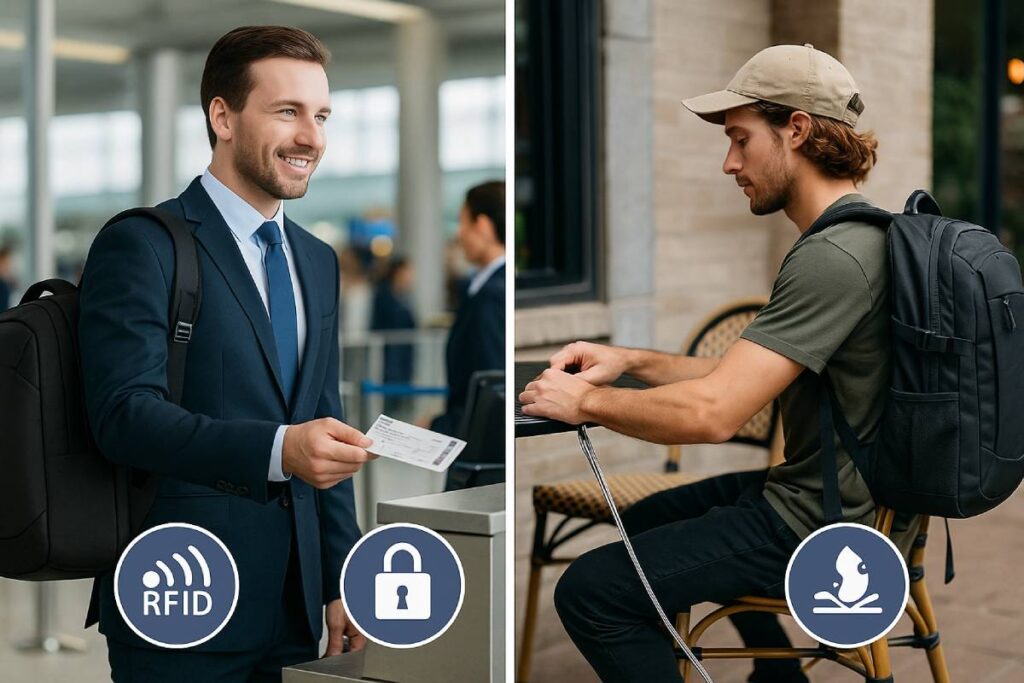
Below is a practical breakdown of how different traveler types can leverage anti-theft features to protect their gear—whether you’re on a high-stakes business trip or backpacking on a shoestring.
Business Travel: Securing Laptops, Documents, and Power Banks
Business travelers rank device security among their top concerns, with over one-third reporting they’ve had a tech item stolen abroad and 65% expressing anxiety about data safety when traveling¹. Choose a bag with a dedicated, padded laptop compartment that separates your computer from chargers and documents to prevent crushing or accidental zip-offs.
Look for external USB charging ports paired with FAA-approved power-bank sleeves, so your devices stay powered without exposing cables or power packs in open pockets. Finally, use a TSA-approved lock on your briefcase or rolling carry-on to deter casual tampering while still allowing official inspections.
Solo & Female Travelers: Front-Carry Daypacks with Built-In Alarms
Solo and female travelers often cite personal safety as paramount—an integrated 125 dB alarm can startle an attacker and draw attention in seconds, as demonstrated by the iSafe Urban Crew Backpack’s built-in siren and strobe lights. Opt for a front-carry silhouette that lets you keep the bag within sight at all times, with lockable zippers hidden beneath top flaps to foil stealthy stylists. Many bags from Pacsafe include a stainless-steel anchor cable, letting you tether your daypack to a chair or café table so you never have to leave it unattended. Combined, these features deliver peace of mind without sacrificing style or comfort.
Digital Nomads & Photographers: Modular Insert Cubes with Cable Locks
For content creators on the move, the Tenba BYOB 13 insert transforms any backpack into a secure camera bag—its adjustable dividers protect a DSLR plus 3–4 lenses in a compact 13 × 9 × 5 inches module (1.3 lb) for around $66. Pair that with a retractable steel-cable lock from Pacsafe, which can loop through your bag handles and anchor to fixed objects, safeguarding both your backpack and its valuable insert.
A smart-security checklist for nomads also recommends portable safes and RFID-blocking pouches to secure hard drives, passports, and backup drives when you’re co-working in cafes or staying in hostels. This modular approach means you can carry camera gear, laptop, and chargers in one bag—without compromising on protection.
Budget Backpackers: Balancing Cost-Effective Anti-Theft Features
On a tight budget, you can still get strong anti-theft performance for under $50. The SHRRADOO Anti-Theft Laptop Backpack at $29 offers spacious organization and lockable zippers, making it a top value pick for budget travelers. The Travelon Urban Anti-Theft Backpack (around $35) adds smooth, lockable zippers and hidden pockets, earning praise for quietly “sending a message of inconvenience to thieves” in high-risk cities amazon.com. Supplement your loadout with a $20 combination padlock and a simple steel-cable luggage strap for under $25 more—these prevent quick grab-and-run attempts without breaking the bank.
| Budget Feature | Example Product | Price |
|---|---|---|
| Lockable main compartment | SHRRADOO Anti-Theft Laptop Backpack | $29 |
| Hidden front-pocket zippers | Travelon Urban Anti-Theft Backpack | $35 |
| Combination padlock | Basic 3-digit combo lock | $15 |
| Steel-cable luggage strap | Retractable cable lock by Pacsafe | $20 |
By tailoring your bag choice to how and where you travel—whether securing mission-critical devices on a business trip, carrying just a daypack in crowded tourist hotspots, or protecting camera gear as a digital nomad—you’ll strike the perfect balance between security, cost, and convenience.
Maintenance, Durability & Insurance
Here’s a concise guide to keeping your anti-theft travel bag in peak condition, extending its lifespan, and maximizing your chances of a successful insurance claim. Regular cleaning and lock checks preserve water-resistant coatings and security hardware; timely strap replacement and DWR re-treatment maintain durability; and registering your bag’s serial number plus thorough documentation speeds up recovery when things go wrong.
Care Tips
- Cleaning water-resistant coatings: Hand-wash exterior panels with mild soap and lukewarm water, using a soft cloth or sponge to gently remove dirt—never machine-wash or scrub aggressively, which can strip durable water-repellent (DWR) finishes.
- Rinsing & drying: After cleaning, rinse thoroughly to remove soap residue and hang to dry in the shade; direct sunlight or heat can degrade both coatings and fabric fibers.
- Reapplying DWR: When you notice water no longer beads up, restore repellency with a spray-on or wash-in DWR treatment—these products coat bald spots and can be reapplied indefinitely to maintain performance.
- Checking lock function: Once a month, dial through the entire range (e.g., 000–999) to ensure the mechanism rotates smoothly and reset to your code; if you feel grit or binding, dry-lubricate with a graphite-based spray rather than oil, which can gum up internals.
| Task | Frequency | Action & Notes |
|---|---|---|
| Clean waterproof coating | After 5–10 trips or quarterly | Hand-wash with mild soap & lukewarm water; air-dry in shade |
| Test locking mechanism | Monthly | Rotate all dials; ensure smooth action; reset code; dry-lubricate if needed |
| Reapply DWR coating | Annually or when water stops beading | Use spray-on or wash-in DWR products; follow manufacturer instructions |
| Inspect straps | Every 6 months | Check for fraying, loose stitches; note any weakening in buckles or webbing |
Longevity
- Strap replacement: Straps endure the most wear. If you see significant fraying, stretched webbing, or compromised stitching—especially at attachment points—replace them promptly. Most manufacturers (and repair shops) recommend strap replacement within 2–3 years of heavy use, or immediately when damage interferes with load-bearing capacity.
- Fabric re-treatment: DWR coatings abrade off high-contact areas (cuffs, edges) over time. Plan to re-treat at least once per travel season—or sooner if you notice wetting-out—so that your bag stays weather-resistant and durable.
- Hardware checks: Inspect zippers, buckles, and anchor loops for corrosion or bending every six months. Replace any corroded metal parts to prevent sudden failures in the field.
Insurance & Recovery
- Register your serial number: Many brands (e.g., Crash Baggage) provide a unique serial hologram inside the bag. Register it on the manufacturer’s site to activate warranty and streamline future claims—even if you lose your proof of purchase.
- Document everything: For insurance, you’ll need the bag’s serial number, purchase receipt, photos of damage or theft, and a police report if items are stolen. Airlines like Copa explicitly ask for these details in baggage-claim forms.
- File promptly: Most policies require notification within 24–48 hours of an incident and claim submission within 30 days of return. Late filings often get denied, so initiate your claim while details are fresh.
- Know your coverage limits: Check your travel or home-contents insurance for itemized value limits—designer or high-end bags may need declared-value endorsements to be fully protected.
By following these maintenance routines, proactively replacing worn components, and safeguarding your bag’s serial number and documentation, you’ll not only extend your anti-theft bag’s lifespan but also maximize your chance of a smooth recovery if the unexpected happens.
Price-to-Value Considerations
Before diving into specific picks, here’s what you need to know: Budget options under $50 deliver basic RFID-blocking pockets and lockable zippers—perfect for casual travelers who want entry-level protection. Mid-range bags ($50–$150) add integrated slash-proof straps and TSA-approved locks, striking a balance between security and cost. Premium models (>$150) feature full cut-resistant frames, carbon-fiber RFID panels, and often lifetime warranties—ideal for serious globetrotters willing to invest in lifelong reliability.
Budget Picks (< $50)
When you’re traveling light and on a shoestring, these anti-theft bags hit under $50 and still block RFID scans and secure zippers.
| Product | Key Feature | Price |
|---|---|---|
| Indusky Large Travel Backpack | Hidden RFID pocket | $13 |
| Matein Travel Laptop Backpack | Lockable main compartment | $25 |
| Amazon Basics Laptop Backpack | Basic RFID-blocking sleeve | $26 |
| Coofay Waterproof Travel Backpack | Zipper locks & water-resistant fabric | $34 |
| Anti-Theft Metro Convertible Crossbody Bag | Lockable zipper & RFID lining | $30.14 |
| Classic Mini Shoulder Bag | RFID-blocking lining | $46.06 |
These budget-friendly bags typically include basic RFID-blocking pockets and lockable zippers but lack advanced cut-resistant or slash-proof materials.
Mid-Range Picks ($50–$150)
Step up your security game with integrated slash-proof straps and TSA-approved locks—without overspending.
| Product | Key Feature | Price |
|---|---|---|
| VaultPro RFID Gateway Grande Bag | RFID-blocking & lockable zippers | $75 |
| VaultPro RFID Gateway Crossbody | RFID pocket & slash-resistant strap | $72 |
| SwissGear 1900 Scansmart TSA Laptop Backpack | TSA-friendly lay-flat opening | $90 |
These mid-range bags deliver cut-resistant strap reinforcements and official TSA lock compatibility—perfect for business trips and frequent flyers. By investing in mid-range models, travelers gain enhanced durability and government-approved locks without breaking the bank.
Premium Picks (> $150)
For the ultimate in anti-theft protection, premium bags offer full-frame cut resistance, carbon-fiber RFID panels, and sometimes lifetime warranty coverage.
| Product | Key Feature | Price |
|---|---|---|
| LOCTOTE Flak Sack II | Cut-resistant frame & double steel locking strap | $159 |
| TUMI x McLaren Paddock Backpack | Real CX6™ carbon-fiber detailing | $1,395 |
These high-end bags not only thwart cuts and RFID scans but often include comprehensive or lifetime warranties for manufacturing defects—ensuring your investment is protected over years of travel. Although the upfront cost is significant, the durability, advanced materials, and warranty coverage deliver unmatched long-term value.
Conclusion
By now, you’ve seen exactly how each feature—RFID-blocking pockets, hidden zippers, cut-resistant weaves, and TSA-approved locks—addresses a specific theft scenario, from airport overhead bins to hostel bunks. The tech‐and‐material comparison tables let you weigh price against performance, while real-user testimonials prove these features work under pressure.
Practical use-case breakdowns show you which bag suits business travelers, solo adventurers, digital nomads, or budget backpackers. Maintenance advice keeps your investment in peak form, and insurance pointers ensure you’re ready if the worst happens.
Whether you opt for an entry-level pack under $50 or splurge on carbon-fiber panels and lifetime warranties, you now have the insights to choose with confidence. Protect what matters most—your data, documents, and devices—so you can focus on the journey, not the what-ifs.
FAQs
What makes RFID-blocking pockets effective?
RFID pockets use metallized or carbon-fiber linings to create a Faraday cage around your cards and passport chips, blocking scanners up to 13.56 MHz.
Can TSA-approved locks really keep my luggage safe?
They prevent casual tampering and allow authorized inspections, but master-key leaks mean determined thieves may still breach them.
How do I clean water-resistant coatings?
Hand-wash with mild soap in lukewarm water, rinse fully, air-dry in shade, and reapply DWR spray when water no longer beads.
When should I replace slash-proof straps?
Inspect every six months for fraying or stiffness; replace within 2–3 years of heavy use or immediately after visible damage.
Are premium anti-theft bags worth the cost?
If you travel frequently with high-value gear, lifetime warranties and carbon-fiber panels offer unmatched long-term value.

